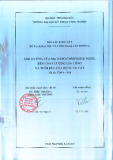
Original
article
Micropropagation
and
restricted-growth
storage
of
adult
oak
genotypes
K
Gebhardt,
U
Frühwacht-Wilms
H
Weisgerber
Forschungsinstitut
für
Schnell
Wachsende
Baumartin,
Prof
Oelkersstr
6,
D-3510
Hann
Münden,
Germany
Summary —
The
winter
buds
of
stump
sprouts,
epicormic
shoots
and
grafts
from
adult
pedunculate
and
sessile
oak
trees
proved
to
be
valuable
sources
of
shoot
tips.
Established
shoot-tip
cultures
ex-
hibited
long-term
viability.
Proliferation
and
vitality
of
new
shoots
was
best
from
the
base
part
of
shoots
if
the
callus
tissue
remained
at
the
basal
stem
segment.
Aged
callus
cells
are
involved
in
the
process
of
xylogenesis
which
inhibits
organogenesis.
Root
initiation
depends
upon
optimum
auxin
supply
but
auxin
causes
side
effects
on
shoot
elongation
and
callus-cell
proliferation.
Shoot-tip
ne-
crosis
was
prevented
if
shoots
with
induced
roots
were
subcultured
on
cytokinin-containing
medium.
The
labor
and
expense
of
repeated
subculture
can
be
reduced
by
lowering
growth
temperature
to
15,
10
or
4
°C.
By
using
abscisic
acid
(0.1 -
10
μM)
and
applying
polyethylene
glycol
(mol
wt
4000)
at
concentrations
of
4
and
8%,
the
inhibition
of
biomass
accumulation
will
continue
over
2
regular
subculture
periods
on
media
without
growth
retarding
substances.
Quercus
/
in
vitro
culture
/
bud
/
temperature
/
conservation
Résumé —
Micropropagation
et
conservation
de
chênes
âgés
sous
conditions
limitant
la
croissance.
Les
bourgeons
de
rejets
de
souche,
de
pousses
épicormiques
et
de
greffes
issus
de
plants
âgés
de
chêne
pédonculé
et
sessile
constituent
un
excellent
matériel
pour
la
culture
de
seg-
ments
de
tiges.
lis
manifestent
une
longue
viabilité.
Les
meilleures
viabilité
et
prolifération
ont
été
obtenues
sur
du
matériel
prélevé
à
la
base
des
segments.
Les
cellules
âgées
des
cals
sont
impli-
quées
dans
la
xylogenèse
qui
inhibe
l’organogenèse.
L’initiation
des
racines
dépend
d’un
niveau
op-
timal
d’auxines;
mais
la
production
d’auxine
a
des
effets
négatifs
sur
l’élongation
de
la
tige
et
la
proli-
fération
des
cals.
La
nécrose
des
extrémités
racinaires
peut
être
évitée
si
les
pousses
issues
de
racines
sont
cultivées
sur
du
milieu
contenant
des
cytokinines.
Le
coût
en
temps
et
en
main
d’œuvre
occasionné
par
les
subcultures
répétées
peut
être
réduit
en
diminuant
la
température
jusqu’à
4°C.
L’utilisation
d’acide
abscissique
(0,1
à
10
μM)
et
l’application
de
polyétylène
glycol
(poids
molécu-
laire
de
4
000)
à
des
concentrations
de
4
à
8%
permet
de
prolonger
l’inhibition
de
la
production
de
biomasse
pendant 2
périodes
de
subcultures
sur
du
milieu
ne
contenant
pas
de
substance
de
crois-
sances
à
effet
retardant.
Quercus
/ culture
in
vitro
/ bourgeon / température / conservation

INTRODUCTION
By
the
method
of
shoot-tip
culture,
it
is
possible
to
preserve
oak
germplasm
but
the
success
of
propagation
depends
upon
the
degree
of
juvenility
in
the
starting
ma-
retial,
on
the
method
of
sterilization,
specif-
ic
requirements
of
nutrients,
hormones,
cultural
conditions
and
genotype,
as
de-
scribed
by
Chalupa
(1985,
1988),
Maroti
et
al
(1985),
Vieitez
et
al
(1985),
San-José
(1986),
Pevalek-Kozlina
and
Jelaska
(1986),
Civinova
and
Sladky
(1987),
Favre
and
Juncker
(1987),
Meier-Dinkel
(1987),
Sasaki
et
al
(1988),
Meier
and
Gross
(1989)
as
well
as
Vermeer
and
Evers
(1990).
Restricted-growth
storage
of
shoot-tip
cultures
is
an
effective
method
for
the
preservation
of
forest
genetic
resources
(Gebhardt
and
Meier-Dinkel,
1990).
It
is
appropriate
for
oak
trees
because
adult
genotypes
cannot
be
propagated
by
cuttings
and
long-term
seed
storage
is
not
possible.
The
labor
and
expense
of
repeat-
ed
subculture
can
be
reduced
by
lowering
growth
temperature
(Meier-Dinkel,
1990),
the
use
of
chemical
growth
regulators
and
the
application
of
hypertonic
osmotica.
MATERIALS
AND
METHODS
Shoot-tip
cultures
were
established
from
closed
winter
buds
of
adult
trees
as
described
earlier
(Gebhardt
et
al,
1991).
In
order
to
prevent
the
browning
of
the
shoot
tips,
ascorbic
acid
was
added
to
the
disinfectant.
Shoot
tips
were
placed
on
GD-medium
(Gresshoff
and
Doy,
1972)
supplemented
with
0.2
mg/l
benzylade-
nine
(BA),
2%
sucrose,
100
mg/l
myo-inositol.
Prior
to
autoclaving
the
pH
was
adjusted
to
5.7.
The
media
were
solidified
with
0.28%
Gelrite
(Kelco).
Shoot-tip
cultures
were
kept
in
a
growth
chamber
at
26 °C
in
a
16
h
photoperiod
sup-
plied
by
cool
white
fluorescent
lamps
(1500
lux).
Elongated
shoots
were
dissected
from
develop-
ing
shoot
clusters
and
subcultured
monthly.
The
low
temperature
storage
was
examined
with
5
genotypes
(n
=
300)
cultivated
on
GD-
and
woody
plant
(WP)-medium
(Lloyd
and
McCown,
1980)
supplemented
with
0.5
mg/l
BA
with
5
rep-
licates
for
each
temperature
(4,
10,
15 °C)
at
re-
duced
light
(100-300
lux).
For
each
storage
pe-
riod
(8
and
20
wk)
the
accumulation
of
biomass
(fresh
weight
of
shoots)
was
determined
before
and
after
the
test
period
and
after
subsequent
periods
of
subculture.
Abscisic
acid
(ABA)
was
added
to
WP-medium
supplemented
with
0.5
mg/l
BA
at
final
concentrations
of
0.1,
1.0
and
10
μM.
After
a
test
period
of
4
weeks,
the
bio-
mass
accumulation
was
compared
(n
=
48).
Two
subculture
periods
of
4
weeks
followed
and,
with
regard
to
the
amount
of
callus
cells,
the
recovery
of
shoot
tips
was
determined
on
a
control
medium
without
ABA.
Polyethylene
gly-
col
(PEG)
was
used
as
hypertonic
osmoticum
at
concentrations
of
4
or
8%
in
a
WP-medium
sup-
plemented
with
0.5
mg/l
BA.
Microscopy
Callus
tissue
was
fixed
and
stained
with
0.25%
safranin
as
described
by
Gebhardt
and
Gold-
bach
(1988).
Specimens
were
embedded
in
Rot-
iplast
(Roth,
6642),
sectioned
at
a
thickness
of
20
μm
and
mounted
in
Roti-Histokitt
(Roth
no
6638)
after
removal
of
the
embedding
material
with
Rotihistol
(Roth,
6640).
In
UV
light
(excita-
tion
436
nm)
lignified
cell
walls
exhibit
green
flu-
orescence,
while
cellulose
stains
yellow.
RESULTS
Adults
trees
provide
buds
from
different
positions
with
a
varying
degree
of
juvenili-
ty.
To
compare
the
regeneration
capacity
of
different
bud
sources,
the
current
years’
shoots
of
the
tree
crown,
epicormic
shoots
and
stump
sprouts
were
used
as
sources
of
shoot
tips.
Overall,
54
sterile
cultures
of
different
genotypes
and
bud
sources
were
established
but
most
of
them
remained
non-viable
for
more
than
3
subcultures.
As
demonstrated
en
figure
1,
the
viability
of
shoot-tip
cultures
was
related
to
the
origi-

nal
position
of
the
explants.
From
20
geno-
types
established
by
the
use
of
stump
sprouts,
9
(45%)
remained
viable
for
a
pe-
riod
of
more
than
800
days.
If
epicormic
shoots
were
used
as
a
bud
source,
the
success
rate
dropped
to
18%
of
the
geno-
types.
Only
1
of
23
genotypes
from
buds
out
of
the
tree
crown
exhibited
long-term
viability.
In
order
to
micropropagate
select-
ed
trees
of
specific
oak
stands,
chip-
budded
grafts
were
established
and
pro-
vided
a
bud
source
with
a
long-term
viabili-
ty
of
37
(Quercus
robur)
to
56%
(Q
petraea
Matt
Liebl).
The
proliferation
of
new
shoots
from
leaf
axils,
at
stem
base
or
along
the
shoot
axis,
was
promoted
by
the
addition
of
0.2
or
0.5
mg/l
BA.
It
is
assumed
that
new
shoots
de-
velop
from
axillary
as
well
as
from
trace
buds
which
are
released
by
the
apical
mer-
istem
but
remain
dormant
for
a
certain
pe-
riod
of
time.
In
older
trees,
the
activity
of
trace
buds
leads
to
the formation
of
epicor-
mic
shoots.
In
shoots
derived
from
shoot-
tip
culture,
the
formation
of
new
shoots
is
related
to
the
activity
of
the
shoot
apex
which
can
be
very
different,
even
if
shoots
are
placed
on
the
same
media.
Elongated
and
rooted
shoots
frequently
exhibited
shoot-tip
necrosis
and
stopped
elongation
growth.
Shoot-tip
necrosis
was
stimulated
by
subculture
on
cytokinin-free
media.
It
was
prevented
by
a
dip
treatment
of
the
shoot
apex
using
50
mg/l
BA
(15
s)
or
by
subculture
on
BA-containing
media.
In
or-
der
to
prevent
shoot-tip
necrosis
caused
by
an
auxin
treatment,
we
removed
shoots
from
an
auxin-containing
medium
(GD-
medium
with
50%
macro-
and
microele-
ments,
0.5
mg/l
BA,
1.0
mg/l
indole-3-
butyric
acid
(IBA)
after
9,
11,
13,
16
and
18
days
of
root
induction
and
subcultured

them
on
WP-meduim
supplemented
with
0.5
mg/l
BA.
The
mean
number
of
roots/
shoot
increased
from
1.6
after
9
days
incu-
bation
to
4
roots/shoot
after
16
days
incu-
bation
on
auxin-containing
medium.
Shoot
elongation
was
also
best
after
16
days
on
auxin-containing
medium.
Callus
cell
pro-
liferation
at
stem
base
was
lowest
after
13
days
of
auxin
treatment.
Callus
tissue
remained
partly
green
if
subcultured
on
BA-containing
medium.
If
shoots
with
a
large
callus
at
stem
base
were
cut
back
and
subcultured
on
BA-
containing
media,
new
shoots
arose
from
the
stem
base.
These
shoots
exhibited
vig-
orous
growth,
long
internodes
and
small
leaves
with
juvenile
character.
This
sug-
gests
that
the
callus
tissue
at
stem
base
can
partly
compensate
for
the
lack
of
a
root
system
because
of
its
large
surface.
If
the
callus
tissue
was
subcultured
twice,
the
release
of
polyphenols,
as
indicated
by
the
browning
of
cells
and
surrounding
me-
dium,
was
enhanced.
As
demonstrated
by

microscopy,
callus
cells
are
converted
into
tracheary
elements.
Tracheary
elements
exhibit
aberrant
secondary
wall
deposition
and
are
subjects
to
autolysis
(Roberts,
1976).
Irregular
patterns
of
lignified
vascu-
lar
tissue
were
formed
but
cambial
activity
was
not
observed.
In
order
to
reduce
labor
and
expense
of
repeated
subculture,
we
lowered
the
growth
temperature
of
shoot-tip
cultures
from
the
normal
of
26 °C
to
15,
10
and
4 °C.
The
subculture
period
of
5
genotypes
on
2
media
was
prolonged
from
the
normal
of
4
weeks
to
8
and 20
weeks.
To
separate
the
effects
of
temperature,
media
and
sub-
culture
period,
a
multivariate
analysis
of
variance
was
calculated.
As shown
in
fig-
ure
2,
the
accumulation
of
biomass
(fresh
weight)
decreased
significantly
at
10
and
4 °C.
Cold
temperatures
in
storage
stimu-
lated
considerably
the
accumulation
of
bio-
mass
after
storage.
Accumulation
of
bio-
mass
after
storage
was
less
if
shoots
were
stored
on
WP
medium
instead
of
GD
medi-
um
but
the
number
of
shoots
developed
af-
ter
storage
was
the
same
(fig
3,
A).
The
extension
of
the
subculture
period
resulted
in
a
smaller
number
of
regenerated
shoots.
The
recovered
mass
accumulation
was
not
significantly
less
(fig
3,
B).
When
we
com-
pared
the
mass
accumulation
of
shoots
dif-
fering
in
the
amount
of
callus
at
stem
base
during
the
course
of
storage,
it
became
ob-
vious
that
shoots
with
a
large
amount
of
callus
cells
may
decrease
in
fresh
weight
even
during
a
short
storage
period.
This
might
be
due
to
the
process
of
xylogenesis
and
the
resulting
conversion
of
tissue.
Abscisic
acid
was
added
to
WP-medium
at
final
concentrations
of
0.1,
1.0
and
10
μM.
At
1
and
10
μM,
significant
inhibition
of
growth
became
obvious
when
the
biomass
accumulation
after
storage
was
compared.
After
a
subculture
period
of
4
weeks,
the





![Báo cáo seminar chuyên ngành Công nghệ hóa học và thực phẩm [Mới nhất]](https://cdn.tailieu.vn/images/document/thumbnail/2025/20250711/hienkelvinzoi@gmail.com/135x160/47051752458701.jpg)










